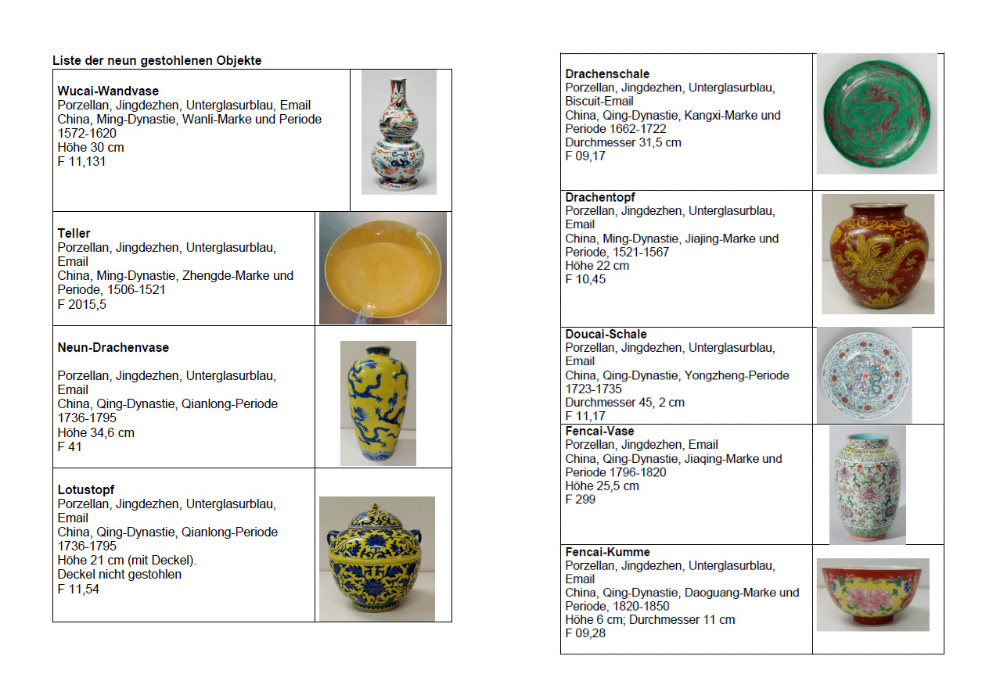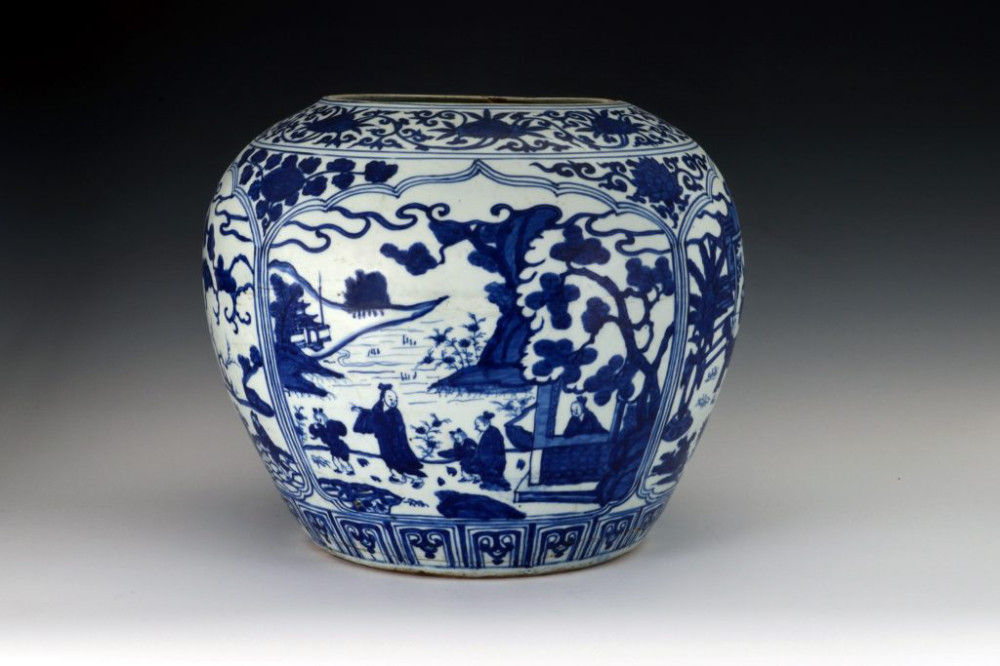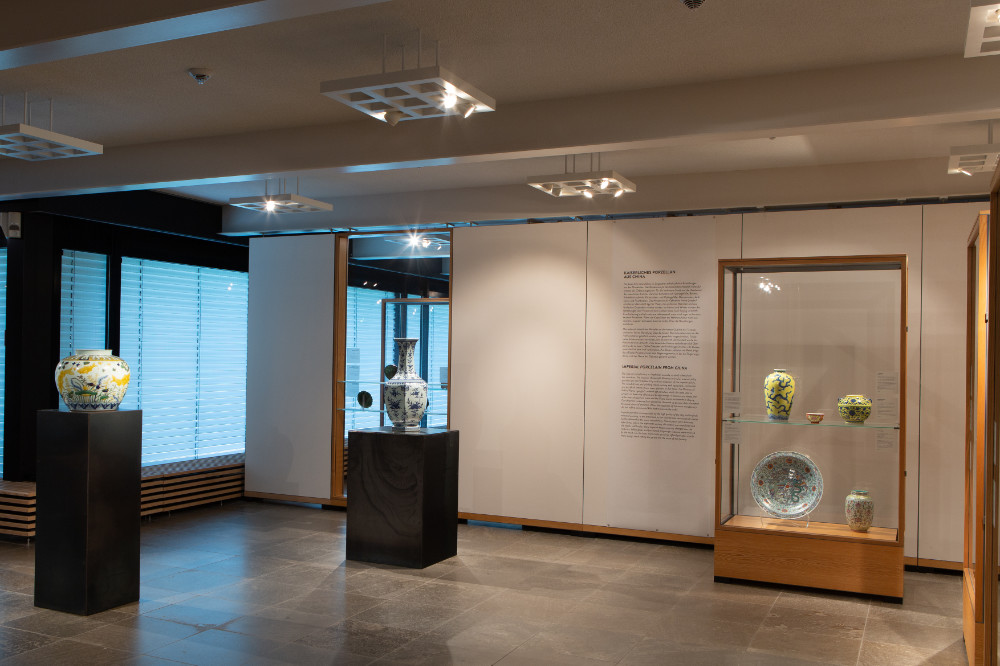German Museums Continue to be Hit by Wave of Burglaries
by Lisa Scheffert and Daniel Baumbach, translated by Maike Meßmann
Time and again, we cover break-ins at museums in Germany. It is shocking how often audacious perpetrators achieve their goals, as the Manching case proved recently. And yet, we “only” tell you about cases that involve the theft of coins, medals or orders. If you look further, there are many more incidents. Not all of them are big enough for us to hear about them in the daily news. We present two examples from autumn 2023.
Content
A Burglary in Cologne
It is midnight on 13 September 2023: A security guard of the Cologne Museum for East Asian Art hears loud noises and sees two burglars leaving the museum. One man is about 25 to 30 years old, with mid-long hair and a baseball cap. The other man is believed to be about 30 to 40 years of age, and carried a grey square rucksack of the type used by food delivery services. They stole nine porcelain plates, vases and pots from the Ming and Qing dynasties with a total value of about 1 million euros. It seems like the thieves had specifically targeted the most valuable objects of the museum.
Director Shao-Lan Hertler, who had only been in office for two months at the time of the theft, said that it was particularly tragic that almost all stolen exhibits were part of the holdings that the founding couple of Adolf and Frieda Fischer had acquired for the museum between 1906 and 1911. And yet, Hertel emphasised that the objects were well-recorded and recognisable, which is why there is hope that they will find their way back into the museum one day.
As early as in January 2023, burglars had made their way into the Museum for East Asian Art and had even started to remove some objects. However, they then set off the alarm and decided to get out without the objects. This was followed by a strange incident in June. A pane of glass on the side façade of the museum was smashed. However, the perpetrators did not enter the museum and thus no objects were stolen.

The list was created by the Museum for East Asian Art, hoping that the stolen objects could be recovered if the broad public learned about the burglary. Photo: © RBA/MOK
Would It Have Been Possible to Prevent the Burglary?
In September 2023, perpetrators used the smashed window to their advantage. After all, the pane had not been repaired yet. A wood panel was meant to seal the broken window temporarily, but the burglars removed it. So far, we do not know whether there is a connection between the three incidences or whether it was mere coincidence.
Hindsight is always 20/20: the burglary sparked major debates about the security of the museum – why were there no appropriate measures in place, why did the alarm not go off, why had the window not been repaired yet given the two previous attempted break-ins. As usual, the answer probably has to do with money. The good news is: a new window was ordered, an expensive custom-made pane of ballistic glass. In mid-March the new window is to replace the second temporary solution that has been around since September. Unfortunately, it is a recurring problem that funds for such measures are only made available after a break-in, despite the Rheinisches Landesmuseum in Trier already proving in 2019 that preventative measures can stop burglars.

One of the stolen objects: a shoulder pot from the time of the Ming dynasty. Photo: © Roemer- und Pelizaeus-Museum.
A Burglary in Hildesheim
Another incident occurred in the night from 29 to 30 October in Hildesheim: Burglars smashed a glass panel on the first floor of the Roemer- und Pelizaeus-Museum. What was first considered an unsuccessful break-in attempt on the morning of 30 October, proved to be a burglary three days later. Three objects of the important China collection of Ernst Ohlmer had been stolen: two candlesticks and a shoulder pot. In its press release, the museum stated that the burglary was probably carried out by professional criminals that acted on someone else’s behalf.
A Solution?
By now, the museum has opened a new permanent exhibition on the topic of food and drink – and has drawn a sad conclusion form the burglary. Its press release reads: “Additional security measures require time and money. This is not just a problem in Hildesheim. Our new permanent exhibition could only be realised with major restrictions: we drastically reduced the number of displayed objects. Both the porcelain and other valuable items such as the prince-bishop’s silverware, which is of specific historical importance to the city of Hildesheim, will remain in a safe. Many showcases display pictures instead of the actual objects. Despite the restrictions, the diversity of the objects in our museum’s collections is still visible.”
The Tip of the Iceberg
These two cases are by no means the only ones that happened in recent months. In Griesheim, Hesse, thieves targeted a museum in January; cash boxes and a small safe containing cash were stolen. In Middle Franconia, the military museum near Marktbergel was broken into around New Year’s Eve. Unidentified perpetrators entered the museum through a window and stole historical orders, uniforms and sabres with an estimated value of 30,000 euros; in addition to the caused damage of 5000 euros due to broken doors and display cases. Shortly before Christmas, there was a break-in at the Grafenwöhr Culture and Military Museum, where thieves stole the contents of a donation box as well as cash from the register. And we could add numerous other instances to this list.
In these days, museums are always out of money. Small institutions in particular simply do not have the funds to protect themselves against break-ins by implementing expensive security features. Will other museums follow the example of Hildesheim and refrain from exhibiting genuine objects due to security concerns? That would be a pity. And yet, it would be understandable.









